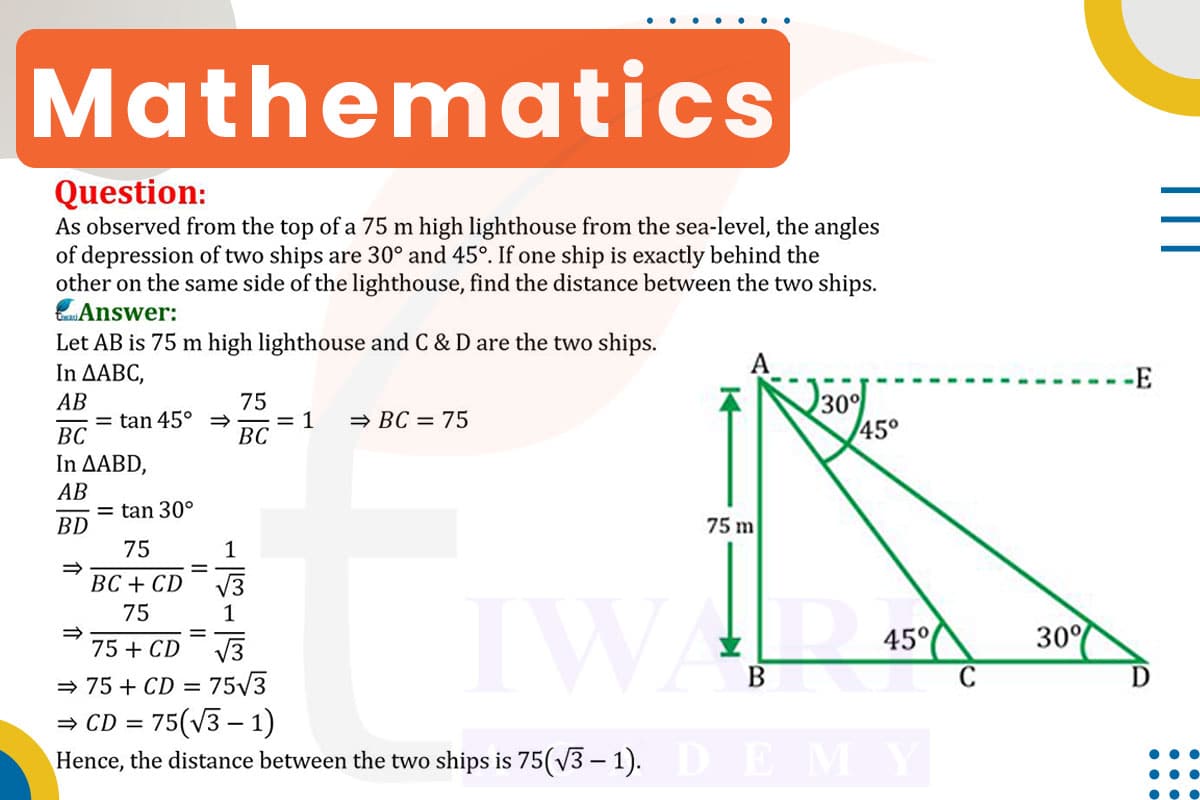To find the distance between the two ships, we use trigonometry, specifically the tangent function related to the angles of depression. The angles of depression from the lighthouse to the ships are the same as the angles of elevation from the ships to the top of the lighthouse.
For the Ship at 30° Angle of Depression: Using tan(30°) = 1/√3, the distance to the first ship (d1) is given by 1/√3 = 75/d1. Solving for d1, we get d1 = 75√3.
For the Ship at 45° Angle of Depression: Using tan(45°) = 1, the distance to the second ship (d2) is d2 = 75 m.
The distance between the two ships is d1 − d2 = 75√3 − 75, which simplifies to approximately 44.98 meters. Therefore, the distance between the two ships is about 44.98 meters.

Let’s discuss in detail
Trigonometric Analysis in Nautical Navigation
Trigonometry, a fundamental branch of mathematics, is extensively used in nautical navigation, particularly for determining distances and angles from a fixed point. The problem at hand involves the use of trigonometry to calculate the distance between two ships as observed from the top of a lighthouse. By analyzing the angles of depression to the ships, we can determine their distances from the lighthouse and subsequently the distance between them. This scenario is a practical demonstration of how trigonometry can be applied in maritime navigation and safety.
Understanding the Problem: Lighthouse Observation
The problem presents a lighthouse that is 75 meters high. From the top of this lighthouse, the angles of depression to two ships are observed to be 30° and 45°, respectively. The ships are located on the same side of the lighthouse, with one directly behind the other. The objective is to find the distance between these two ships. This setup forms two right-angled triangles, one with each ship, with the lighthouse as the common vertex.
The Role of Tangent in Angle of Depression
In trigonometry, the tangent of an angle in a right-angled triangle is the ratio of the length of the opposite side to the length of the adjacent side. The angles of depression from the lighthouse are equivalent to the angles of elevation from the ships to the lighthouse. By applying the tangent function to these angles, we can calculate the distances of the ships from the lighthouse.
Calculating the Distance to the First Ship
For the ship at a 30° angle of depression, we use the tangent function. The equation is tan(30°) = 1/√3 = 75/d1, where d1 is the distance to the first ship. Solving for d1, we find d1 = 75√3 meters. This distance is crucial for determining the relative positioning of the two ships.
Determining the Distance to the Second Ship
Next, we apply the tangent function to the 45° angle of depression for the second ship. The equation is tan(45°) = 1 = 75/d2, where d2 is the distance to the second ship. Since
tan(45°) = 1, it follows that d2 is equal to 75 meters.
Calculating the Distance Between the Ships
The distance between the two ships is the difference between d1 and d2, which is 75√3 − 75 meters. This calculation simplifies to approximately 44.98 meters. This example illustrates the practical application of trigonometry in maritime navigation, demonstrating how it can provide accurate measurements for safety and operational purposes. Trigonometry proves to be an invaluable tool in nautical scenarios, offering a mathematical approach to solving problems where direct measurement is challenging or impossible.
Discuss this question in detail or visit to Class 10 Maths Chapter 9 for all questions.
Questions of 10th Maths Exercise 9.1 in Detail


